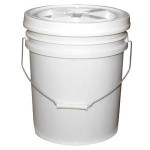A nutrient solution system typically consists of a two or three part liquid solution containing the essential diet for a plant added to clean tap water. The manufacturer of the nutrient solution will include or reference a feeding schedule recommended for various common types of plants. Unfortunately, most minerals are mined and processed by the manufacturers, however, many offer an organic option while some specialize in only organic.
-

nutrient starter kit
I recommend starting with General Hydroponics Flora Series Performance Pack, consisting of the main three liquid parts, several enhancements, and the pH test kit. There is also an organic line of products. (Handy tip: If you ask General Hydroponics or other nutrient solution vendors for samples of their products, you can usually get free or discounted trial sizes.) A word of caution about miracle growing fertilizers, do not add any fertilizers other than those you know to be hydro-friendly, as it can cause a nutrient build-up harming your plants.
Making Your Own Nutrient Solutions
There are several challenges involved in making your own nutrient solution. Sourcing the raw minerals needed, breaking-down properly so that the plants are able to absorb the nutrients, and filtering out unwanted materials that will clog the flow of nutrient solution through the system while maintaining a proper pH and hoping that you didn’t inadvertently introduce an undesirable pest into a closed-system.
Experiment with microfungals: Make your own hydroponic compost tea
Nutrient Solution Management
The most common vessel for transporting and storing water is the 5-gallon plastic bucket, also commonly available in 3-gallon as well. The most common method for managing liquid is to use ½” diameter vinyl tubing and fittings.
If we do not monitor the nutrient solution concentration and the pH then the plants will reach a point where they will show signs of stress.
What is EC?
The electrical conductivity (EC) of water estimates the total amount of solids dissolved in water -TDS, (Total Dissolved Solids). TDS is often measured in ppm (parts per million). In hydroponics, this measurement is used to determine the approximate concentration of nutrient solution to water.
As the nutrient solution level decreases it needs to be replenished with freshwater, otherwise the nutrient solution becomes more concentrated and some plants won’t respond well. Add fresh water to bring the concentration back to the level it was when started, often referred to as “topping-off.”
What is pH?
The pH of water is an important measurement whether you are gardening indoors or outdoors, soil or soilless, because it affects whether a plant can properly take in nutrients.
Check the pH and EC periodically and compare it to what is expected for that plant at this stage of growth. There is no need to adjust your pH or EC until it is necessary. There is a lot of misinformation out there about keeping the pH and EC regulated. If I were paranoid, I’d say it was a conspiracy from hydroponics manufacturers and retailers who want to sell more consumable product. Don’t get me wrong, proper pH and EC is important, even critical, to the success of a plant. There are many hand-held EC devices available as well and if you are checking the E.C., it’s a great time to check the pH. Therefore, I recommend a handheld pH tester such as the Oakton EcoTestr pH 2 Waterproof pH Tester, which is excellent for the home gardener and has been proven time and again to be accurate.
When do I need to adjust the pH?
Only under the following conditions: pH is at or below 5.0 or above 6.5
AFTER at least 30 minutes from the time of topping-off or changing the nutrient solution. I recommend using a solution made specifically for this purpose, pH Up and pH Down from General Hydroponics sparingly and only when necessary.
Flushing
Flushing means to literally flush empty the nutrient solution from the hydroponics system and replace it with fresh “good” tap-water. Then return the nutrient solution back to what it should be for the phase of growth. When in doubt, flush the system and refresh the nutrients. Otherwise, it’s recommended to flush your recirculating system every 7 – 14 days. When I grow, I try to keep the nutrient solution working as long as possible, however, salts build-up over time and it is good to flush with fresh water from time to time.
Using float switches:
- Top float switch used to indicate vessel is full of liquid.
- Middle float switch provides warning or triggers a pump to refill.
- Bottom float switch turns off pumps and notifies attendant that vessel is out of liquid.
Flow-rate: A hall-effect flow sensor’s data can be used to determine the flow rate of the liquid being pumped.
Please share with friends and click follow to receive a notification when I publish a new article. As I receive feedback from you, I will update these sections, so don’t be afraid to comment or send me your questions directly.








Leave a comment